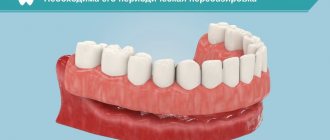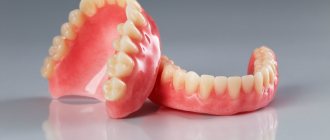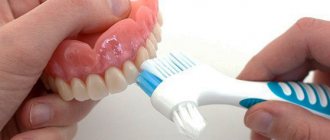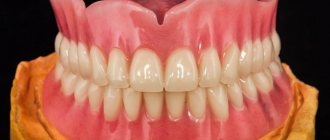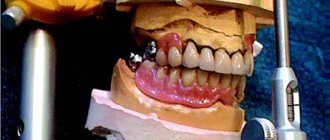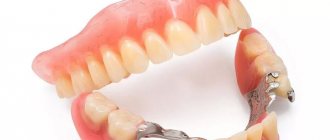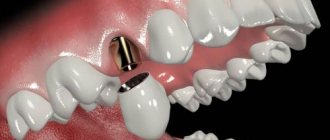Indications for relining Correction methods Relining materials Where to do it?
The basis for comfortable use of removable orthopedic systems is a reliable fit to the jaw. But gradually the fixation of the structure weakens, functionality decreases, and discomfort appears when eating and talking. Relining a denture (partial, complete) – involves eliminating inaccuracies, preventing damage to the base of the structure, restoring precise contact with the gums and supporting dental units. Depending on the clinical case, such a procedure is performed in the dentist’s office or in a laboratory setting.
When is denture relining necessary?
After fixing the new orthopedic system, after the first 1-3 months
wearing, relining the denture is necessary to correct the accuracy of its fit to the mucosa. Because the teeth were missing for some time, the jaw joint was rebuilt. After installing the prosthetic structure, the load on the jaw tissue changes. It begins to gradually atrophy, the gums sag, and the bite begins to change. The prosthesis becomes uncomfortable and the occlusion is disrupted.
Relocation shown:
- if the structure does not hold well in the mouth, falls out during conversation, eating, or puts pressure on the gums;
- in the presence of defects in the prosthetic system due to violations of technology during impression taking or manufacturing;
- deterioration of the aesthetic characteristics of the structure;
- the prosthesis has been damaged or has flaws;
- the shape of the alveolar process has changed, which caused instability of the orthopedic structure;
- an atypical change in the height of the lower part of the face was detected (even if the deviation is minimal from the original parameters).
Correction is needed not only for removable models, but also for conditionally removable structures supported by implants. Mostly, these are single-stage protocols with instant load (all-on-4, all-on-6). After implantation of implants and installation of a prosthetic system, the load on the bone increases. This leads to enhanced regeneration of bone tissue and an increase in its parameters, which requires correction of the orthopedic apparatus. That is, if the bite changes, the position of the prosthetic system changes.
Rules for using removable dentures
When everything has been checked and all errors have been corrected, the doctor tells the patient how to use the prosthesis:
“You need to get used to the prosthesis,” says the doctor. – Everyone gets used to it differently. Usually around 5-7 days. I advise you to wear the prosthesis around the clock for the first five days, and only take it off for cleaning.
At first you may feel nauseous. Drooling will increase. The prosthesis will be very annoying. This is normal and should go away in 1 day.
I advise you to somehow distract yourself. Work, an exciting movie or a good book. Everything will do.
It will be difficult to speak at first - talk more and it will pass
For the first 5 – 7 days, eat soft, it is better to grind food. Then gradually switch to normal
After eating, the dentures should be washed and the mouth rinsed. The denture should be cleaned twice a day. Buy a special brush; regular toothpaste will do. Clean your dentures in the morning after breakfast and in the evening after dinner. Place the denture in the box at night. But first, soak it in an antiseptic solution for an hour. There are special elixirs and tablets. But, for example, a chlorhexidine solution is also suitable.
In the morning, brush your gums and tongue with a soft toothbrush. This will improve blood circulation in the gums and freshen your breath.
Well, that’s it, I’m making an appointment for you tomorrow, I need to make sure that the prosthesis doesn’t interfere.
If it rubs too much, remove it. But be sure to put it on 3 hours before coming to see me. I have to see exactly where the prosthesis is in the way.”
The doctor says goodbye to the patient, but his work with this prosthesis does not end there. No matter how hard the doctor and technician try, the prosthesis often rubs and needs to be adjusted.
Correction methods
Relining a complete removable denture, as well as restoring a partial structure, is carried out by two methods - clinical (in the dentist's office) and laboratory. If the design does not fit well enough, the doctor will be able to adjust it in front of the patient; this takes a minimum of time. If there is a significant violation of the fit, or a decrease in the height of the bite, additional equipment will be needed; correction is carried out in a laboratory. How dentures are relined depends on the complexity of the work and the type of prosthetic system.
Clinical method
The procedure includes the following stages of prosthesis relining:
- assessment of bite, occlusion, compliance of the orthopedic design with the jaw relief;
- adjusting the structure, filing edge elements (lengthening, shortening);
- removal of polishing from the orthopedic system, preparation of the polymer mass;
- distribution of the polymer composition onto the treated surface of the prosthesis;
- installation of an orthopedic system for the patient, with complete closure of the teeth of the upper and lower jaw (assessment of central occlusion);
- removal of excess polymer mass from the structure, polymerization of plastic (if there is a metal base, a layer of the corresponding metal is sprayed onto the inner surface of the prosthesis, then a plastic mass is applied to the metal base);
- immersion in hot water for final polymerization, improving adhesion strength;
- modeling of the edge segment, finishing polymerization.
The clinical method allows you to immediately eliminate all shortcomings and achieve a tight fit of the prosthetic system to the gums. The technique is not used in the presence of infectious and inflammatory diseases of the oral mucosa or allergies to plastic.
Laboratory method
Relining the prosthesis base in the laboratory allows you to avoid the negative impact of the plastic composite on the mucous membrane, but you will have to wait several days for the result.
- The doctor assesses the condition of the prosthetic structure, takes an impression of the patient’s teeth and sends everything to the laboratory;
- a thin layer of plastic is removed from the orthopedic system, the polishing is removed from the edge segment;
- the required amount of plastic is applied to the structure, its boundaries are formed, ground, polished, and the closure in the position of central occlusion is checked;
- the finished orthopedic system is returned to the doctor, who installs it for the patient.
Among the advantages of the technique are high aesthetics of the prosthetic system, maximum adhesion of materials (base, relining polymer), and absence of allergies to the plastic composite. Relining plate dentures in the laboratory takes 2 days or more
. There is no adaptation to the adjusted orthopedic device, since the patient has already used it before.
Fit and apply the prosthesis.
- He carefully examines the prosthesis from all sides. Looks for sharp edges, protrusions, roughness on the inside of the prosthesis (The inside is the side that lies on the mucous membrane. The outside faces into the oral cavity). If flaws are found, the doctor immediately cuts them off with a cutter (Plastic is always processed with a cutter).
The doctor looks at the quality of the prosthesis. Is there any porosity (gas, granular, compression porosity, remember?). Is it well polished? Are your teeth aligned correctly?
- When the doctor is sure that everything is in order, he disinfects the prosthesis. And puts it on the patient’s jaw.
- The prosthesis should be easy to put on. In the upper jaw, it may be hampered by excessively large maxillary cusps. On the lower side there are undercuts in the retromalar area, on the lingual side. Then the doctor grinds off the base on this side. First on one side (left or right). If it doesn't help, then do both.
Grind off where number 3 is - When the doctor places the prosthesis on the jaw, he checks how well it holds. The doctor presses his finger on the front and side teeth. The prosthesis should not come off. The doctor checks the fixation of the back of the prosthesis by pressing his finger on the front teeth, pushing them towards the lips. The front part - pulling the incisors down or up - depends on the jaw. The stability of the prosthesis is checked in motion. No, the patient is not forced to run. Just move the lower jaw in different directions.
- The practitioner checks for balanced occlusion. He must correct what the technician was not able to fully create. Using occlusal paper (carbon paper), the doctor checks uniform interdental contacts. If they are not there, the doctor selectively grinds the teeth with a small milling cutter, trying to preserve the anatomical shape of the teeth. Until you achieve perfect occlusion.
- The doctor checks the boundaries of the prosthesis using Herbst tests (They were described in the article about taking impressions). The point is that with certain movements, the necessary muscles at the border of the prosthesis tense. And if something is wrong, the prosthesis will be reset. Although it holds up well in a relaxed mouth.
When checking, the doctor may find errors that he had not noticed before. Either he was a fool, or the technician made a mistake, who will figure it out now. In any case, we looked at some errors here. And we don’t want to repeat them. Anyone interested will read it. There were only three types of errors left that were not considered. This is a shortening of the borders of the prosthesis and shortening on the side of line A. And balancing.
Types of relining material
Correction of removable laminar dentures involves the use of the following materials:
- Hard plastic
– cold-curing acrylics (Protacryl, Redont), hot-curing acrylates (Ethacryl, Ftorax, etc.), polymethyl methacrylate. Solid base plastics are used for rigid fixation of orthopedic systems or laboratory relocation. - Soft composites
– acrylic, silicone elastomers. It is used if the physical parameters of the orthopedic device are normal, but the patient experiences headaches and discomfort. Typically used for relining mandibular prosthetic structures. - Temporary elastics
(conditioners) – polyvinyl chlorides and silicone base materials are highly elastic and are used for soft relining of dentures in case of systematic inflammation of the gums. Elastic materials are characterized by particular softness and are intended to reduce and uniformly redistribute chewing pressure to sensitive areas of the mucosa. Temporary material should be regularly updated, as it reacts negatively to cleaning agents and is susceptible to the accumulation of bacterial plaque.
The cost of relining an orthopedic system depends on several parameters - the technology used, material, type (clasp, conditionally removable, removable), size of the prosthesis, etc.
How to do this without a doctor?
A first aid remedy can be KAMISTAD GEL, produced in Germany, anesthetizes the wound, as it contains lidocaine. It also promotes healing.
Solcoseryl is a dental adhesive paste that promotes wound healing and relieves pain, made in Switzerland.
If you do not have the opportunity to sharpen a removable denture, METROGYL DENTA, made in India, has an antiseptic and ANTI-MICROBIAL effect.
It is possible to combine KAMISTAD + METROGYL DENTA or SOLCOSERYL + METROGYL DENTA
If in a removable denture you find and remove as quickly as possible, sharpen the part that is pressing, then ANESTHEATH and ANTIMICROBIAL components will not be needed.
As a rule, even the most severe cuts in the cavity heal quickly once the cause of the injury is eliminated!
Where to contact
Patients with removable orthopedic devices are recommended to see an orthopedist every 6 months
for relocation of the structure. This must be done for preventive purposes, since due to a violation of the fixation of the orthopedic system in the mouth, breakage of the structure, rapid loosening and loss of supporting teeth (with partial structures) may occur.
To restore a prosthesis in Moscow, it is most convenient to contact the RUTT network of clinics. Relining is carried out using modern cushioning materials from reliable manufacturers, which guarantees precise fit of the restored structure, uniform distribution of the chewing load, and long service life.
Expert of the article Alekperov Roman Borisovich Dentist-orthopedist, doctor of the first category
Work experience24 years


